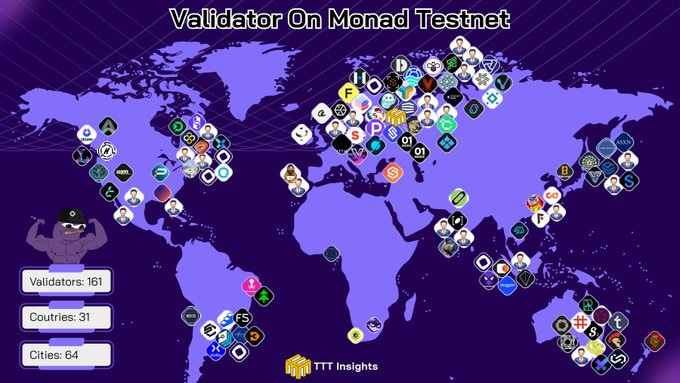Validator Count vs Real Decentralization: Monad’s RaptorCast
In blockchain discourse, decentralization is often mistakenly equated with validator count. Ethereum, for example, now operates with roughly one million validators. On the surface this sounds impressive, but research shows that decentralization cannot be measured by numbers alone. What truly matters is whether those validators are independent, geographically distributed, and running on diverse infrastructure. If the majority of validators are concentrated in one region or dependent on the same hosting providers, the system may appear decentralized in quantity but not in reality. By contrast, even a network with 100–200 validators can be more genuinely decentralized if those validators are globally dispersed and controlled by diverse actors.
Metrics such as the Nakamoto coefficient, node distribution maps, and infrastructure diversity analyses repeatedly demonstrate that validator count by itself is insufficient. Real decentralization is achieved through diversity and distribution, not sheer numbers. This framing matters because while increasing validator count does strengthen security and decentralization in theory, it also introduces a new paradox: the chain gets slower as validators increase.
The history of blockchains has revolved around the same tension: balancing security, decentralization, and scalability. Adding more validators improves the first two, but paradoxically makes the chain slower.
To understand why, consider a block production round. When a new block is created, it must be propagated to all validators in the network. In small networks this is simple: the leader proposes a block, a handful of validators approve, signatures are collected, and the block finalizes. But once the validator set grows into the hundreds or thousands, the dynamics change. The leader must transmit the same block hundreds of times, the network carries redundant copies of the same data, and signature aggregation takes longer. In theory this should scale linearly, but in practice the communication overhead grows quadratically. With 100 validators, tens of thousands of messages; with 1,000 validators, millions. Latency rises, finality slows, and the chain’s tempo stalls.
The source of this slowdown lies not in the consensus rules themselves but in the propagation layer. Most blockchains rely on gossip protocols for block distribution. Gossip is resilient, since if data is lost it resurfaces from another peer, but it is not deterministic. The same block circulates multiple times. In small networks this inefficiency is invisible, in large networks it becomes a hidden tax that undermines performance. For this reason, many chains intentionally limit validator counts: they want more security but cannot afford the communication overhead.
Monad takes a different path. Instead of reinventing the consensus algorithm, it redesigns the messaging layer. The result is RaptorCast, not just another propagation protocol but a dedicated block distribution engine.
Rather than sending an entire block in one piece, the leader breaks it into small chunks using erasure coding. Redundant chunks are added so that even if some are lost, the block can still be reconstructed. These chunks are distributed through a two-level tree: the leader sends only to the first tier of validators, and they in turn forward chunks to the rest. Load is no longer concentrated at the center but spread across the network in proportion to stake. Transmission happens over UDP rather than TCP, so there is no connection setup cost, and packet loss is absorbed by redundancy. This guarantees that propagation time is capped at a deterministic upper bound, roughly twice the one-way latency between the farthest two nodes in the network.
This architecture delivers two critical outcomes. First, the leader’s bandwidth burden becomes independent of validator count, scaling only with block size. Second, performance remains stable as the validator set grows, because propagation time is pinned to the physical limits of the network rather than the number of participants. In Monad’s testnet, this translates into concrete numbers: 400 ms block times and 800 ms finality. A block proposed on the network becomes irreversible in under a second, even with a large validator set.
Placed in a broader context, the distinction becomes sharper. Ethereum’s libp2p gossip ensures redundancy but provides no deterministic timing, the same data may linger for seconds. Solana’s Turbine uses tree-based fan-out and erasure coding but under different design constraints. Monad’s RaptorCast combines a strict two-hop tree with Raptor codes to provide both deterministic latency bounds and validator-count independence.
The conclusion is clear: the long-standing paradox of “more validators = slower chain” is not an immutable law of consensus mathematics, but a solvable problem of network engineering. By rethinking the propagation layer, Monad’s RaptorCast demonstrates that decentralization and speed can coexist. And this may well foreshadow a broader lesson: the fastest blockchains of the future will be built not only on new consensus algorithms, but also on innovations in the messaging layer that underpins them.
References
Gencer, A. E., Basu, S., Eyal, I., van Renesse, R., & Sirer, E. G. (2018). Decentralization in Bitcoin and Ethereum Networks. arXiv:1801.03998.
Kim, Y., Kwon, H., Kim, H., & Cho, S. (2022). Measuring Node Decentralisation in Blockchain Peer-to-Peer Networks. ResearchGate.
Ethereum Research. Geographical Decentralisation Discussion.
Monad Docs. Monad Architecture and RaptorCast.
Solana Labs. Turbine Protocol.





